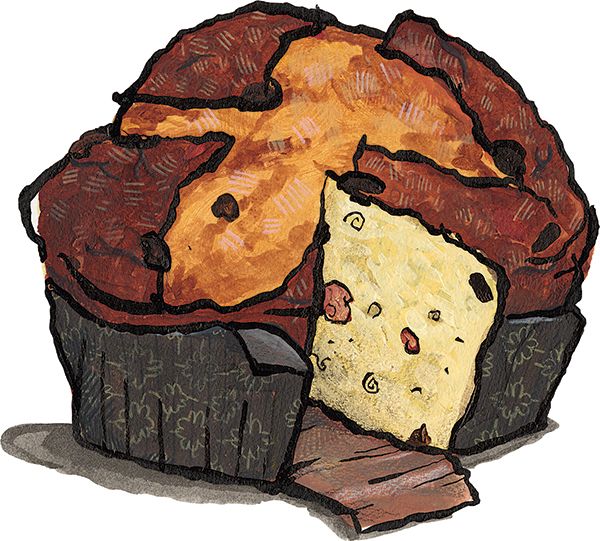There are plenty of stories about the origins of panettone, Italy’s most famous Christmas dessert, but the most romantic is this: once upon a time in Milan a poor baker named Antonio had a beautiful daughter who caught the eye of a local nobleman. When Antonio’s bakery was in danger of going out of business, the nobleman sold his most prized possession—his falcons, the sports car of pre-industrial barons—in order to pay for Antonio’s ingredients to make a special bread for Christmas. The new bread was the talk of the town. It was so successful that the bakery was saved, and in gratitude the baker’s daughter married the nobleman and they lived happily ever after. Importantly for us, Antonio’s recipe caught on. Italians have been eating Tony’s bread—”Pan de Toni,” eventually strung together into “panettone“—at Christmas ever since.
Today, Panettone is THE Christmas dessert of Italy.
Italians say they know Christmas is soon when the panettone starts showing up in shop windows and on cafe menus. And there’s lots of it. Each year nearly 120 million are baked. That’s for a population of about 60 million Italians. Let’s think about that for a minute. One foot-wide panettone is more than enough for a family to share with plenty of leftovers. And yet there are two made for every person in the country.
Antonio’s tale aside, the panettone we know today—and its status as Italy’s ubiquitous Christmas dessert—is thanks to the work of Milanese baker Angelo Motta. In 1919, when Motta opened his first bakery, panettone was still only known in Milan. It was more or less a regular round loaf of bread, a little sweet, seasoned with candied fruit and citrus, not all that rich. Motta tweaked the recipe and created the cake we know today. The first change he made was to leaven the cake with a natural starter, like the kind that would be used for a sourdough bread. In addition to giving the panettone a fluffy, pillowy texture, the natural starter also allows the panettone to keep for weeks and still taste fresh. Motta also added a lot more butter to his panettone, inspired by the rich kulich bread he made for Easter for the Russian community in Milan. The additional fat weighed down the dough, so Motta began baking his panettoni in tall, narrow paper pans, creating the high-rising shape we know today. He packaged his new tall cakes in beautifully designed cartons. They were an overnight success. Within a decade his four bakeries weren’t enough to keep up with demand so he opened a factory. Other Milanese bakers took notice and started growing their own production. In particular, a baker named Gioacchino Alemagna became so popular as to challenge Motta’s panettone preeminence.
For the next several decades, Motta and Alemagna were known throughout Milan as rivals. The Milanese took sides as to whose panettone was best. Both bakeries commissioned artists to produce gorgeous advertisement posters. Production grew, costs went down, and their rivalry fueled advertising campaigns further afield. Before long, panettone took over the country as the Christmas cake of choice. Today more than half of it is sold in southern Italy—the opposite end of the country from Milan.
In Antonio’s day, the hot new trends in the medieval confectionary world were luxuries brought back to Europe by the crusaders: citrus and sugar. Citrus was so precious that in order to not waste any bit of it, the peels were commonly candied. The addition of candied fruit pops up in Christmas sweets across medieval Europe: stollen in Dresden, panforte in Siena, fruitcake in England. Today, the most traditional panettone still contains plenty of candied fruit and citrus peel. But over the last several decades it seems just about every in vogue flavor has shown up in panettone, from marrons glacés to beer. In addition to a traditional panettone, this holiday we have one with chocolate and figs, and one laced with syrupy ribbons of balsamic.
Panettone is one of those foods where every Italian family has their own way of eating it.
One of my favorites dates back at least 500 years, to the Duke of Milan, where the head of the household cuts three large pieces and then every member of the family eats a bit of each piece for good luck. I know a family that likes to cut the top off their panettone, scoop out (but not discard!) the inside, fill it up with homemade whipped cream, then put the top back on. When they go to serve the cake it looks normal, but the cream hidden inside is a sumptuous surprise. And our purchasing manager, Joe, likes to make his panettone into super luscious French toast.
Panettone makes a beautiful addition to a holiday spread. Serve it for dessert with sparkling wine and, if you’re feeling decadent, a scoop of mascarpone. Or nibble on it in the afternoon with a mug of tea or coffee. If there are leftovers, they make for ridiculously good bread pudding.

